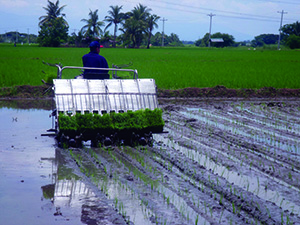 Rice transplanting is becoming easier and convenient. With the use of mechanical rice transplanter, a farmer need not stand and bend his body for long hours of transplanting. The machine does the work while the farmer-operator sits, maneuvers, and oversees the operation.
Rice transplanting is becoming easier and convenient. With the use of mechanical rice transplanter, a farmer need not stand and bend his body for long hours of transplanting. The machine does the work while the farmer-operator sits, maneuvers, and oversees the operation.
The fabrication of this machine was made possible through the effort of the Philippine Rice Research Institute (PhilRice) and funding support from the Philippine Council for Agriculture, Aquatic and Natural Resources Research and Development of the Department of Science and Technology (DOST-PCAARRD). PhilRice developed the six-row, riding type rice transplanter based on a Korean model. The machine is able to transplant 2-6 seedlings per hill at a planting depth of 2-6 cm, hill spacing of 12-18 cm and row spacing of 30 cm. With this machine, transplanting the 14 to18-day old seedlings in a 2-hectare land can be completed in a day.
Recently, PCAARRD approved the implementation and funding of a two-year project to test the transplanter in pilot areas in Luzon, Visayas, and Mindanao. Three units will be deployed in Nueva Ecija, lloilo, and Midsayap, North Cotabato. The machine will be tested in terms of its acceptability and performance under different technical, economic, social, geographical, and environmental conditions. The final prototype will also be tested for its durability. Test results will serve as the basis for modifying the machine, making it more technically efficient, economically viable, socially acceptable, until it becomes commerciable.
The project, led by Dr. Arnold S. Juliano of PhilRice, will train and accredit manufacturers in the pilot provinces. Trained manufacturers will fabricate the three units for pilot testing. Farmer organizations in the pilot areas will be trained on the machine’s operation and maintenance, after which, data on its technical performance will be gathered and analyzed. Surveys and interviews will be conducted to measure the users’ acceptability.
The project is expected to develop a commerciable prototype of the machine, draft intellectual property claims, and assist in accrediting and licensing of manufacturers.
Farmers, seed growers, seed centers and cooperatives, irrigators’ association, non-government organizations, and private local manufacturers will benefit from this technology.
